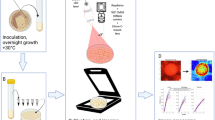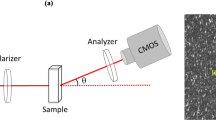Abstract
This paper reports on the biospeckle processing of biological activity using a visualization scheme based upon the digital imaging information technology. Activity relative to bacterial growth in agar plates and to parasites affected by a drug is monitored via the speckle patterns generated by a coherent source incident on the microorganisms. We present experimental results to demonstrate the potential application of this methodology for following the activity in time. The digital imaging information technology is an alternative visualization enabling the study of speckle dynamics, which is correlated to the activity of bacteria and parasites. In this method, the changes in Red-Green-Blue (RGB) color component density are considered as markers of the growth of bacteria and parasites motility in presence of a drug. The RGB data was used to generate a two-dimensional surface plot allowing an analysis of color distribution on the speckle images. The proposed visualization is compared to the outcomes of the generalized differences and the temporal difference. A quantification of the activity is performed using a parameterization of the temporal difference method. The adopted digital image processing technique has been found suitable to monitor motility and morphological changes in the bacterial population over time and to detect and distinguish a short term drug action on parasites.














Similar content being viewed by others
References
Guerini MN, Arthur TM, Shackelford SD, Koohmaraie M (2006) Evaluation of Escherichia coli O157: H7 growth media for use in test-and-hold procedures for ground beef processing. J Food Prot 69(5):1007–1011
Clay RS, Court TH (1932) The history of the microscope. Charles Griffin
Rabal HJ, Braga Jr RA (2008) Dynamic laser speckle and applications. CRC Press
Ansari MZ, Nirala AK (2013) Assessment of bio-activity using the methods of inertia moment and absolute value of the differences. Optik 124(6):512–516
Braga RA, Nobre CMB, Costa AG, Sáfadi T, Da Costa FM (2011) Evaluation of activity through dynamic laser speckle using the absolute value of the differences. Opt Commun 284(2):646–650
Arizaga R, Trivi M, Rabal H (1999) Speckle time evolution characterization by the co-occurrence matrix analysis. Opt Laser Technol 31(2):163–169
Braga RA, González-Peña RJ, Viana DC, Rivera FP (2017) Dynamic laser speckle analyzed considering inhomogeneities in the biological sample. J Biomed Opt 22(4):045010–045010
Arizaga R, Cap NL, Rabal H, Trivi M (2002) Display of local activity using dynamical speckle patterns. Opt Eng 41(2):287–294
Martí-López L, Cabrera H, Martínez-Celorio RA, González-Peña R (2010) Temporal difference method for processing dynamic speckle patterns. Opt Commun 283(24):4972–4977
Minz PD, Nirala AK (2014) Intensity based algorithms for biospeckle analysis. Optik 125(14):3633–3636
Fujii H, Nohira K, Yamamoto Y, Ikawa H, Ohura T (1987) Evaluation of blood flow by laser speckle image sensing. Part 1. Appl Opt 26(24):5321–5325
Gnyawali SC, Blum K, Pal D, Ghatak S, Khanna S, Roy S, Sen CK (2017) Retooling laser speckle contrast analysis algorithm to enhance non-invasive high resolution laser speckle functional imaging of cutaneous microcirculation. Sci Rep 7:41048
Godinho RP, Silva MM, Nozela JR, Braga RA (2012) Online biospeckle assessment without loss of definition and resolution by motion history image. Opt Laser Eng 50(3):366–372
Cojoc D, Finaurini S, Livshits P, Gur E, Shapira A, Mico V, Zalevsky Z (2012) Toward fast malaria detection by secondary speckle sensing microscopy. Biomed Opt Express 3(5):991–1005
Murialdo SE, Sendra GH, Passoni LI, Arizaga R, Gonzalez JF, Rabal H, Trivi M (2009) Analysis of bacterial chemotactic response using dynamic laser speckle. J Biomedical Opt 14(6):064015–064015
Murialdo SE, Passoni LI, Guzman MN, Sendra GH, Rabal H, Trivi M, Gonzalez JF (2012) Discrimination of motile bacteria from filamentous fungi using dynamic speckle. J Biomed Opt 17(5):0560111–0560115
Ramírez-Miquet EE, Martí-López L, Contreras-Alarcón OR (2011) Escherichia coli activity characterization using a laser dynamic speckle technique. Rev Cub Fis 28(1E):1E13–1E17
Ramírez Miquet EE, Martí López L, Contreras Alarcón OR (2011) Dos configuraciones diferentes para la descripción temporal de actividad de Escherichia coli mediante speckle dinámico. Rev Mex Fis 57(5):446–451
González-Peña RJ, Braga RA, Cibrián RM, Salvador-Palmer R, Gil-Benso R, San Miguel T (2014) Monitoring of the action of drugs in melanoma cells by dynamic laser speckle. J Biomed Opt 19(5):057008–057008
Vladimirov AP, Novoselova IA, Mikhailova YA, Bakharev AA, Yakin DI (2016) The use of laser dynamical speckle interferometry in the study of cellular processes. J Biomed Photonics Eng 1(2)
Ansari MZ, Ramírez-Miquet EE, Otero I, Rodríguez D, Darias JG (2016) Real time and online dynamic speckle assessment of growing bacteria using the method of motion history image. J Biomed Opt 21 (6):066006
Ansari MZ, Grassi HC, Cabrera H, Andrades EDJ (2016) Real time monitoring of drug action on T. cruzi parasites using a biospeckle laser method. Laser Phys 26(6):065603
Dell’ Aquila A (2009) Digital imaging information technology applied to seed germination testing: a review. In: Agron sustain Dev. Springer, pp 377–388
Voigt H, Classen R (2002) Computer vision and digital imaging technology in melanoma detection. In: Semin oncol, vol 29. Elsevier, no 4, pp 308–327
Ansari MZ, da Silva LC, da Silva JVP, Deana AM (2016) Modelling laser speckle photographs of decayed teeth by applying a digital image information technique. Laser Phys 26(9):095602
Perry CA, Hajna AA (1944) Further evaluation of EC medium for the isolation of coliform bacteria and Escherichia coli. Am J Public Health Nations Health 34(7):735–738
Atlas RM (2010) Handbook of microbiological media. CRC press
Ramírez-Miquet EE, Darias JG, Otero I, Rodríguez D, Murialdo S, Rabal H, Trivi M (2015) Biospeckle technique for monitoring bacterial colony growth with minimal Photo-Exposure time associated. In: Braidot A, Hadad A (eds) VI Latin American congress on biomedical engineering CLAIB 2014, Paraná, Argentina 29, 30 & 31 October 2014. Springer International Publishing, Cham, pp 313–316
Wyatt PJ (1969) Identification of bacteria by differential light scattering. Nature 221(5187):1257–1258
Bae E, Aroonnual A, Bhunia AK, Robinson JP, Hirleman ED (2008) System automation for a bacterial colony detection and identification instrument via forward scattering. Meas Sci Technol 20(1):015802
Bae E, Bai N, Aroonnual A, Bhunia AK, Hirleman ED (2011) Label-free identification of bacterial microcolonies via elastic scattering. Biotechnol Bioeng 108(3):637–644
Nassif R, Pellen F, Magné C, Le Jeune B, Le Brun G, Abboud M (2012) Scattering through fruits during ripening: laser speckle technique correlated to biochemical and fluorescence measurements. Opt Express 20 (21):23887–23897
Chiquero MJ, Pérez-Victoria JM, O’Valle F, González-Ros JM, del Moral RG, Ferragut JA, Castanys S, Gamarro F (1998) Altered drug membrane permeability in a multidrug-resistant Leishmania tropica line. Biochem Pharmacol 55(2):131–139
Triton TR, Yee G (1982) The anticancer agent adriamycin can be actively cytotoxic without entering cells. Science 217(4556):248–250
da Silva Rodrigues JH, Ueda-Nakamura T, Corrêa AG, Sangi DP, Nakamura CV (2014) A quinoxaline derivative as a potent chemotherapeutic agent, alone or in combination with benznidazole, against Trypanosoma cruzi. PloS one 9(1):e85706
Grassi HC, García LC, Lobo-Sulbarán ML, Velásquez A, Andrades-Grassi FA, Cabrera H, Andrades-Grassi JE, Andrades EDJ (2016) Quantitative laser biospeckle method for the evaluation of the activity of trypanosoma cruzi using VDRL plates and digital analysis. Plos Neglect Trop Dis 10(12):e0005169
Acknowledgements
The authors thank the Arteche brothers from CEADEN who collaborated in the automation of the setup presented. H. Cabrera gratefully acknowledges ICTP TRIL as well as the Associateship Programmes.
Author information
Authors and Affiliations
Corresponding author
Ethics declarations
Conflict of interests
The authors declare that they have no conflict of interest.
Ethical approval
This article does not contain any studies with human participants or animals performed by any of the authors.
Informed consent
Informed consent was obtained from all individual participants included in the study.
Rights and permissions
About this article
Cite this article
Ramírez-Miquet, E.E., Cabrera, H., Grassi, H.C. et al. Digital imaging information technology for biospeckle activity assessment relative to bacteria and parasites. Lasers Med Sci 32, 1375–1386 (2017). https://doi.org/10.1007/s10103-017-2256-0
Received:
Accepted:
Published:
Issue Date:
DOI: https://doi.org/10.1007/s10103-017-2256-0




